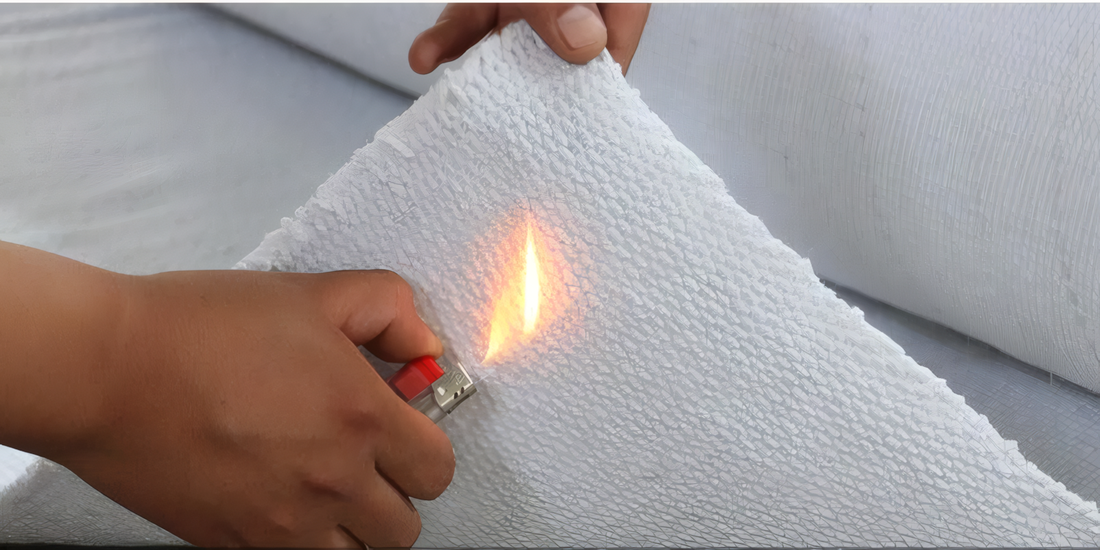
Fire Safety Regulations for Interior Design Materials: What You Need to Know
Share
Fire safety is a critical consideration for anyone working in architecture, interior design, or fit-out construction. With an increasing focus on creating aesthetically pleasing and functional spaces, understanding fire safety regulations for interior design materials is more important than ever. In Australia, compliance with strict fire safety standards is not just a legal obligation—it is a matter of public safety. Materials must meet rigorous testing to ensure they minimise fire risks without compromising design or functionality.
For textile suppliers, architects, interior designers, and fit-out contractors, this guide will provide essential insights into Australian fire safety standards, the importance of compliant materials, and how innovative solutions like Acunic acoustic textiles can elevate safety and design simultaneously.

The Importance of Fire Safety in Interior Design
Fire safety regulations are in place to protect lives, reduce property damage, and provide a structured response in case of emergencies. When it comes to interior design, materials used for walls, ceilings, partitions, and furnishings can greatly impact the spread of fire and the production of smoke or toxic gases. Non-compliance not only risks lives but can result in severe legal and financial penalties.
In high-risk environments such as hospitals, schools, and public buildings, the stakes are even higher. Choosing fire-compliant materials that meet Australian Standards ensures that your designs do not compromise safety. Acunic textiles, for instance, are engineered with Trevira CS fabrics to offer Group 1 fire resistance while maintaining unparalleled acoustic and aesthetic performance.
Overview of Australian Fire Safety Regulations
Australia has some of the strictest fire safety regulations globally. The standards that govern the use of materials in interior spaces are essential for creating safe environments. For textiles and other building materials, compliance is assessed based on various factors, including combustibility, heat release, smoke generation, and toxicity.
Key standards include:
- AS 5637.1-2015: This standard outlines methods for assessing the fire hazard of wall and ceiling linings. Materials are classified into groups (Group 1 being the most fire-resistant).
- AS/NZS 3837-1998: Specifies the procedure for determining material flammability using a cone calorimeter.
- BCA Fire Hazard Properties (National Construction Code): Provides guidelines for the minimum fire resistance of materials used in buildings, ensuring occupant safety.
For textiles like Acunic, meeting Group 1 classification means they provide the highest level of fire safety, making them suitable for critical environments such as healthcare, education, and commercial spaces.
What Makes a Material Fire-Safe?
A fire-safe material is one that minimises ignition potential, reduces flame spread, and limits smoke and toxic gas production. Testing for fire safety involves simulating real-world fire scenarios to evaluate how the material behaves under specific conditions.
Key properties evaluated during fire testing include:
- Ignition Resistance: How easily the material catches fire.
- Flame Spread Index: The rate at which fire spreads over the material’s surface.
- Smoke Development Index: The amount of smoke generated during burning.
- Toxicity: The presence of harmful gases produced when the material burns.
Acunic acoustic textiles meet and exceed these criteria. Engineered with advanced polywoven 3D technology and Trevira CS fabrics, they not only resist fire but also maintain their performance, even under extreme conditions.
Fire Safety Requirements for Specific Interior Design Applications
Different applications in interior design demand varying levels of fire resistance. Here’s how Australian fire standards apply to common design elements:
- Wall Panels and Partitions: Wall panels and partitions often cover large surface areas, making them critical in controlling flame spread. Australian Standards require these materials to achieve at least Group 2 classification for most applications. However, in public spaces, healthcare facilities, and schools, Group 1 materials are preferred. Acunic wall panels, for instance, are crafted to meet Group 1 classification, offering both fire safety and superior noise reduction (NRC up to 0.9).
- Ceiling Sails and Suspended Panels: Ceiling materials contribute significantly to fire safety since heat and smoke rise during a fire. Compliant ceiling materials must meet the flammability and smoke requirements outlined in AS/NZS 3837-1998. Acunic ceiling sails provide exceptional acoustic absorption and are fire-resistant, ensuring compliance with safety standards while enhancing spatial design.
- Curtains and Drapery: Soft furnishings like curtains and drapery can quickly ignite and spread fire. Fire-safe textiles are critical in ensuring these elements do not become a hazard. Australian fire safety regulations require curtains used in commercial or public spaces to meet strict flammability requirements.
Acunic curtains, made from Trevira CS fabric, deliver Group 1 fire resistance, offering peace of mind without compromising design flexibility.
Acoustic Textiles: A Safe and Stylish Solution
Reducing noise without compromising fire safety can be a challenge. Acunic acoustic textiles solve this dilemma by combining advanced sound absorption with robust fire resistance. These textiles are tested under Australian standards, ensuring they deliver up to 90% sound absorption while meeting Group 1 fire safety classification.
Additionally, Acunic offers unlimited colour customisation and UV printing, allowing designers to achieve their aesthetic vision without sacrificing safety or performance. This balance makes Acunic the go-to solution for architects, interior designers, and contractors seeking stylish, functional, and compliant materials.
The Role of Trevira CS in Fire Safety
Trevira CS fabric is a flame-resistant polyester that meets the highest international safety standards. Its inherent fire-retardant properties eliminate the need for chemical treatments, ensuring long-term performance and safety. Trevira CS fabrics are widely used in commercial applications for their durability, ease of maintenance, and superior fire resistance.
Acunic textiles, crafted from Trevira CS, demonstrate how cutting-edge technology can elevate both safety and design. With no volatile organic compounds (VOCs) or allergens, they are also ideal for sensitive environments like healthcare facilities and schools.
Benefits of Fire-Safe Interior Design Materials
Choosing fire-safe materials like Acunic textiles offers several advantages:
- Compliance with Regulations: Ensures adherence to Australian Standards, avoiding legal and financial penalties.
- Enhanced Safety: Protects occupants by reducing fire risks and smoke hazards.
- Design Flexibility: Unlimited colour and printing options without compromising fire resistance.
- Sustainability: Free from VOCs and allergens, making them eco-friendly and safe for sensitive environments.
- Improved Acoustics: Dual functionality with sound absorption properties, ideal for busy commercial spaces.
FAQs
What is Group 1 fire resistance?
Group 1 is the highest classification under AS 5637.1-2015, indicating the material offers the best fire resistance, including low flame spread and minimal smoke production.
Are fire-safe materials mandatory for commercial buildings in Australia?
Yes, Australian fire safety regulations require materials used in commercial buildings to meet specific fire resistance standards outlined in the NCC.
Can Acunic textiles be used in high-risk environments?
Absolutely. Acunic textiles meet Group 1 fire resistance and are suitable for high-risk environments like healthcare, education, and public spaces.
How does Trevira CS differ from treated fabrics?
Trevira CS is inherently flame-retardant, meaning its fire resistance is built into the fibers. Treated fabrics may lose their resistance over time.
Do fire-safe materials affect acoustic performance?
Not necessarily. Acunic textiles, for instance, deliver up to 90% noise reduction while meeting fire safety standards.
What are the customisation options for fire-safe materials?
Acunic textiles offer unlimited colour customisation, UV printing, and versatile installation options, allowing seamless integration into any design.
Conclusion
Fire safety regulations for interior design materials are non-negotiable, especially in Australia, where strict standards protect lives and property. Choosing compliant materials like Acunic acoustic textiles ensures your projects are not only safe but also stylish and functional. By meeting Group 1 fire resistance and offering advanced customisation, Acunic makes it easier than ever for architects, interior designers, and contractors to create stunning spaces without compromising safety.
For your next project, consider Acunic—a solution where performance meets aesthetics, and safety meets innovation.
• Learn more about Acunic’s acoustic textiles here.
• Explore the Australian fire safety standards here.
